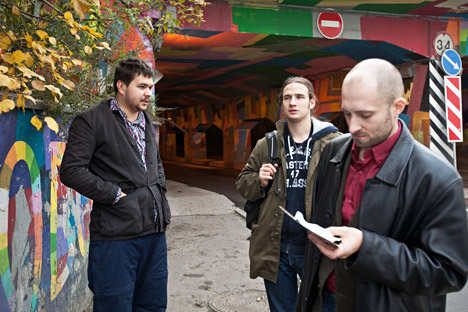
Oleg Melnikov (L), the leader of the anti-slave movement. Source: Kommersant
In Russia, all kidnapping stories almost always sound alike: Someone went to Moscow, disappeared, and then showed up in a few months later. What is behind this modern slave trade?
Oleg Melnikov, the leader of the Alternative, a youth anti-slave labor movement, is dressed like a homeless person, a look targeted by Russia’s modern slave traders. His jacket is a couple of sizes too small, and his pants are too big.
He created his anti-slave trade movement in 2010, and now has just three people supporting him in Moscow and a few in Dagestan. So far, his group has freed more than 120 slaves.
According to various estimates, anywhere from 490,000 to 1 million people are being exploited in Russia. Laws on human trafficking and the use of slave labor were added to the Russian legal code only in 2004, and since them there have been virtually no sentences associated with the exploitation of migrants or slavery in the North Caucasus.
As a result, slave labor exists quite comfortably in Russia. Recruiters with nothing to fear pick up provincials who have no one to help them. According to Alternative, for one broken life they get 3000 rubles ($90), and a male slave, on average, goes for $500 in Russia, the price of a cheap laptop.
Melnikov sits at the train station and baits recruiters; he will accept a beer laced with powerful drugs from him and then end up in an illegal bus heading for the southern Russian region of Dagestan. It takes about an hour for a Caucasian to sit down next to him and start up a conversation. The events begin to rapidly unfold.
The man does actually put Melnikov on a bus. Another Alternative member manages to alert the nearest traffic police, who then stop the bus. They help Melnikov out of the bus. He walks unsteadily and speaks incoherently. They call him an ambulance - he has been seriously poisoned.
All those involved in aiding the homeless in Moscow confirm that such kidnappings occur frequently, yet nobody is preventing them.
"There are different factories in Dagestan," said Anna Fedotov, the coordinator of the Kursk Station of Homeless Children Orthodox organization. "The slaves are released after a certain amount of time. But there are others that are like real concentration camps, where they chain people up and force them to work to death.”
A Russian girl’s road trip through hell
There are many stories of kidnapping people and selling them into slavery. Once Ilya, a lawyer who provides free legal assistance to the homeless, fell into the hands of slave traders.
"At the station, Ilya was given a drink," his colleague Nikita Danov explained. "They told him that as a lawyer, he could find work in Dagestan. They had added something to the alcohol, and Ilya woke up on a bus far from Moscow. He was sent to work at a rock quarry. But after a few days Ilya miraculously managed to get hold of a mobile phone and text me. First I went to the police, but they didn't help me. Then some friends gave me the contact information of one strongman who was working there under cover. In the end, three people entered the stone quarry with guns and brought out Ilya.”
That is usually how slaves are released in Dagestan. Only at the request of relatives will a captured slave be searched for and, hopefully, released. However, not everyone wants to be saved. In Dagestan, deserters from both Chechen wars work for shelter and food, as well as those who have recently been released from prison and have nowhere else to go.
"The real homeless, who knowingly chose this life, do not go to work at the factories because they do not want to work," said Oleg Olkhov, the assistant head of Kursk Station. “The only people who fall into this trap are those who just arrived for work that weren't warned.”
A week after Melnikov is discharged from the hospital, the train from Makhachkala brings a newly freed slave. Alternative members saved Alleg Fetkhulov. He came to Moscow to work and was approached by two Caucasians at the station offering him a drink.
Alleg came to, like the rest of the kidnapped people, in a bus already in Dagestan. Alleg was sent to a factory where the slaves were not beaten, were well fed, and were even given cigarettes. They lived five to a trailer and worked from 6 a.m. to 9 p.m., seven days a week.
Alleg's wife Olga called the authorities. First she went to the Federal Security Service, then to the police, but only the activists of Alternative could help her release Alleg.
Cases of slave labor have been identified not only in the North Caucasus, but also in Bashkiria, Nizhny Novgorod, Voronezh oblast, and Moscow. A year ago, for example, Alternative freed slaves from a grocery store in eastern Moscow.
A women had been kept for years in a basement, she had been beaten, raped, poorly fed, and deprived of sleep. The criminal case was dropped in just two days. They appealed to reopen the case, but the prosecutor's office closed it again. After questioning the store’s owners and their relatives, the case was closed permanently.
First published in Ogonyok magazine.
All rights reserved by Rossiyskaya Gazeta.
Subscribe
to our newsletter!
Get the week's best stories straight to your inbox